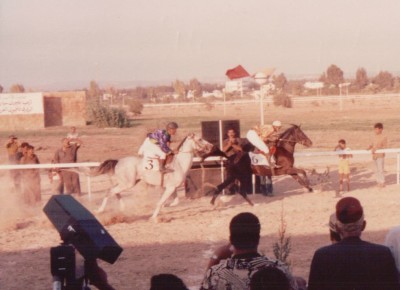Mokhtar winning the Latakia race in 1993
I scanned this archive photo of a famous event among Syrian horse breeders, the Latakia race of 1993, which I attended with my father. Arabians from all over the country and neighboring ones flocked to this national event, the first of its kind on such a scale.
This is a photo of the finish line of the eighth and last race, over a distance of 2000 meters. Mokhtar, Basil Jadaan’s black desert-bred Kuhaylah al-Krush, (now in France and turning 30 next year) won the race, with minimal training. Khalid, Mustafa al-Jabri’s Saqlawi Jadran (Mahrous x Khalidah) came a close second.
The biggest surprise was the third place (not showing in the first picture, but to the right in the second one) of Hakaya, the black desert-bred Shuwaymah Sabbah of the Sheykh of the Bedouin tribe of Tai. She was 15 years old, heavily in foal, ridden bareback, without formal training, by a bulky Tai Bedouin (the others were ridden by professional jockeys), and without a bit… only a Bedouin halter.
Let me write this again to let it sink in: a 15 years old mare, heavily in foal, ridden bareback, without formal training, by a bulky Bedouin, and without a bit coming third in a 2000 meter race.
In the second photo, you can barely see Basil holding Mokhtar’s bridle in the middle (his head almost entirely hidden by the cameraman’s device); the late Mostafa holding Khalid’s bridle to the left, and that Tai Bedouin to the right, riding Hakaya … with the white Bedouin bridle (rashmah). I took the two photos from my seat. I still remember this day vividly.


An amazing feat for the Shuwaymah Sabbah mare! No wonder you remember the day so vividly!
It makes one feel very sad to read about those past days if you compare it to the situation in the area today. I hope and pray for peace!
I agree so much on the sadness, but am so glad that you have these photos and these memories. The two stallions are wonderful, but oh, to have seen that mare in that race!
Magnifique, ces photos auraient pu motiver davantage d’éleveurs en France pour Mokhtar. Ses descendants son precieux!
y a t il moyen d’en avoir davantage? ou bien c’est trop tard pour lui?
Bien d’accord avec toi Arnault.
Edouard, as tu des photos de cette jument : Hakaya ?
oui.. photo et hujjah ici.
http://daughterofthewind.org/photo-and-hujja-of-the-day-hakaya/
Meme lignee que Mahboub Halab. Les Shammar, dont vient la mere de Mahboub ont donne en jument en dot au Tai, dont vient Hakaya, lorsque la soeur de Nouri al-Jarba a epouse la fille du sheykh de Tai.
Le second Khalid par Mahrous et Khalida, cette dernière est saklaoui djedran et est pure dans sa lignée qui ne comporte que des saklaoui djedran, ce qui est rare et qui explique qu’il est typé!
oui, les ‘Adwan etaient tres fiers de leurs saqlawi et ne mettaient que leurs propres etalons saqlawi sur leurs juments. Cela dit, je ne suis toujours pas convaincu, apres 25 ans d’immersion dans l’univers du pur-sang-arabe, que cette technique d’elevage “pure in the strain” est la raison pour laquelle certains chevaux sont plus types que d’autres.
le voila encore, en 1990 cette fois. Ma photo.
http://daughterofthewind.org/horses-of-mustafa-al-jabir-4/
Oui tu as certainement raison les “pure in the strain” ne sont pas spécialement plus typé mais peut être faudrait il parler plutôt d’espèce comme j ai pu le constater avec les managis de Najress et d effat dobeisi ou les Sakalaouis d’al Bazo . c’est aussi le cas de Mokhtar
mr . Edouard i would like to asking regarding dahma um amer – or amir in syria . it.s pure line that almost of them it was not mixing with other lines Since the beginning .
Hakaya had at least 4 registered foals (in Vols 2 to 4 of SYSB), 1 colt & 3 fillies – one of which, the black filly A’fra’ Tai, was by Mokhtar – she was exported to Kuwait in 2002, where she had at least 1 registered foal, a black filly called Mezen imported in utero by Zain Al Khayl – himself a grandson of Hakaya through his sire.
That must be a heck of a filly, because that’s a pedigree in gold..
Salutations and thanks for this wonderful record of a third place win. I have only just been introduced to you by Kina Murray and very much look forward to corresponding with you about Bedouin bridles and Bedouin horsemanship.
I enjoyed reading this thread Edouard. It brings back memories. I went looking through my old photos and I found the one I had taken of Hakaya when she was with the Tai tribe while I was visiting in 1996. She was tethered out with a fine grey mare next to a large mound of barley straw and she was magnificent. So dry and elegant in person with the lovely crisp eyes. And of course this was the 3rd Shuweymah Sabbah mare that I had seen with the Tai. One other I had photographed was a fleabitten grey with an old Bedouin saddle pad that was almost identical to the drawing in Maj. Gen. W. Tweedie’s 1894 book, on page 141. I found myself frequently drawn to the Shuweyma mares that I saw in Syria in 1996.
Yes, the Tai got their Shueymans from the Shammar, through intermarriage between the Jarbah and the Tai leading clan, the ‘Assaf.
Here’s a video of the Syrian goverment or so from 2014 https://www.youtube.com/watch?v=adFGXTitkAo (haven’t seen it before)
Are there more photos of Hakaya and recent information on Syrian asils in Europe? I am looking into these oriental bloodlines, just acquired a wonderful rare Iranian-Egyptian filly of 4 years and looking to breed her in the future to oriental stallions.